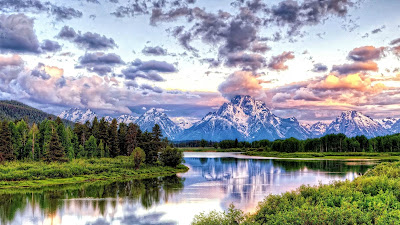Grand Teton National Park includes Jackson Hole and the adjacent Teton Range, and consists of more than 480 square miles of high mountains (maximum height 13,766 feet) coniferous forests, and sage-covered plains between 6,000 and 7,000 feet.
Grand Teton National Park is located in the western United States in state Wyoming. It has around 310,000 acres and it includes the 40 miles long Teton Range.
Lodgepole pine forests drape the shoulders of the Teton Range. These dark0green forests also dot the valley of Jackson, in places where tree roots can found adequate water such as near the Snake River or its tributaries.
Lodgepole pine trunks are long and straight. They were valued by early pioneers for making cabins and other buildings.
Grand Teton National Park together with Yellowstone National Park comprises a strategic core of a vast upland wilderness; five national forests and three other define its parameters.
The history of Grand Teton dates more than 11,000 years back when the nomadic Paleo-Indians migrates to this region during warm months searching for supplies for their existence. Grand Teton National Park was established in 1929 to preserve the most spectacular section of the scenc Teton Range.
With the addition of most of the former Jackson Hole National Monument in 1950, the park was enlarged to its present size.
Grand Teton National Park
Friday, December 9, 2016
The most popular posts
-
Grand Teton National Park includes Jackson Hole and the adjacent Teton Range, and consists of more than 480 square miles of high mountains (...
-
A desert is made of ecosystem. In an ecosystem, plants, animals, land, water and air work together. A desert is one of many types of biome...
-
Deciduous broadleaf forest is the representative vegetation type in the humid temperate zone of Monsoon Asia. It covers the range of latitud...
-
The most important aspect of a rainforest is its biodiversity. Rainforests are home to more than half of the world’s plant and animal specie...
-
Coniferous means the tress have cones, so-called because they are shaped like a geometric cone. The coniferous forest is the largest biom...










